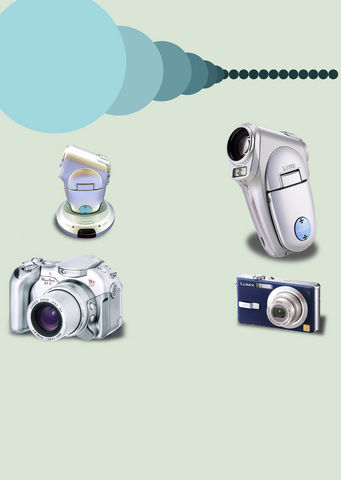It's all too easy to take a photograph these days with the host of super-slim, super-light, fits-in-the-palm-of-your-hand, digital cameras. But if you are taking lots of photos, bumping around at a boisterous party or taking self-portraits, you are all too likely to end up with a case of the shakes -- and the resultant blurry, poorly defined pictures.
But now, technology has come to the rescue of the weary or nervous photographer. A new generation of cameras and recorders now come equipped with image-stabilization functions that will cure the shakes once and for all.
Image stabilization can be achieved through software as in digital image stabilization, most often seen in digital video recorders or still cameras with a DV function.

PHOTO COURTESY OF THE MANUFACTURERS
Digital video stabilization in effect uses software to recalibrate images to ensure that they come out with sharper outlines and greater definition. There is also optical video stabilization, in which the camera is built in such a way so that the lens group is able to shift itself through a plane perpendicular to the optical axis to counter the degree of image shake. This system is primarily found on still cameras.
As always, there are pros and cons. Digital image stabilization can often result in a artificial looking image, while optical image stabilization can be expensive to fix if the camera takes a hard knock that throws the shake sensors out of alignment.
For the well-practiced photographer, image stabilization probably isn't particularly important, but it certainly does no harm and can help improve the definition of photos taken in poor light when longer exposures are demanded.
The new technology is ideal for those who want clear photos without thinking too much about it. Getting shaken about on a train, your image stabilizer will be a godsend in recording the journey. Capturing images far in the distance with a powerful telephoto lens, the stabilizer will go some way to keeping the image sharp and clear, even if you don't have a tripod.
The benefits are particularly clear with something like the Canon Powershot S1 IS with its 10X optical zoom, which allows you to pick and choose your shots from a distance. Moreover, this powerful little camera is equipped with a USM driver to move its zoom through its full range in just one second. (Most other cameras need between four and six seconds to move through 10X of zoom.)
Probably one of the hottest cameras equipped with IS technology is the Panasonic DMC-FX-7 with its 3X Leica DC Vario-Elmarit optical zoom and the MEGA Optical Image Stabilizer system. At only 153g, it has a lot of potential in a tiny package.
If you want to keep a running record, you can check out the Sanyo Xacti C, which combines DV and still-photo functions. With its 3x optical and 12X digital zoom, the corrective measures provided by its digital IS will come in useful for all but those with the steadiest of hands. -- Translated by Ian Bartholomew

On April 26, The Lancet published a letter from two doctors at Taichung-based China Medical University Hospital (CMUH) warning that “Taiwan’s Health Care System is on the Brink of Collapse.” The authors said that “Years of policy inaction and mismanagement of resources have led to the National Health Insurance system operating under unsustainable conditions.” The pushback was immediate. Errors in the paper were quickly identified and publicized, to discredit the authors (the hospital apologized). CNA reported that CMUH said the letter described Taiwan in 2021 as having 62 nurses per 10,000 people, when the correct number was 78 nurses per 10,000

As we live longer, our risk of cognitive impairment is increasing. How can we delay the onset of symptoms? Do we have to give up every indulgence or can small changes make a difference? We asked neurologists for tips on how to keep our brains healthy for life. TAKE CARE OF YOUR HEALTH “All of the sensible things that apply to bodily health apply to brain health,” says Suzanne O’Sullivan, a consultant in neurology at the National Hospital for Neurology and Neurosurgery in London, and the author of The Age of Diagnosis. “When you’re 20, you can get away with absolute

May 5 to May 11 What started out as friction between Taiwanese students at Taichung First High School and a Japanese head cook escalated dramatically over the first two weeks of May 1927. It began on April 30 when the cook’s wife knew that lotus starch used in that night’s dinner had rat feces in it, but failed to inform staff until the meal was already prepared. The students believed that her silence was intentional, and filed a complaint. The school’s Japanese administrators sided with the cook’s family, dismissing the students as troublemakers and clamping down on their freedoms — with

As Donald Trump’s executive order in March led to the shuttering of Voice of America (VOA) — the global broadcaster whose roots date back to the fight against Nazi propaganda — he quickly attracted support from figures not used to aligning themselves with any US administration. Trump had ordered the US Agency for Global Media, the federal agency that funds VOA and other groups promoting independent journalism overseas, to be “eliminated to the maximum extent consistent with applicable law.” The decision suddenly halted programming in 49 languages to more than 425 million people. In Moscow, Margarita Simonyan, the hardline editor-in-chief of the